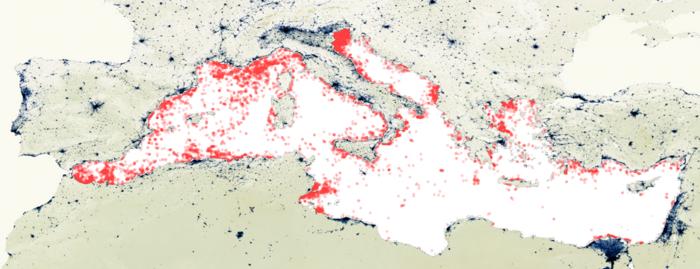Detecting marine debris from space is now a reality, according to a new study led by the Institut de Ciències del Mar (ICM-CSIC) and the University of Cadiz recently published in the prestigious journal Nature Communications. Until now, the amount of litter -mostly plastic- on the sea surface was rarely high enough to generate a detectable signal from space. However, using supercomputers and advanced search algorithms, the research team has demonstrated that satellites are an effective tool for estimating the amount of litter in the sea.

Credit: Manuel Arias / Andrés Cózar
Detecting marine debris from space is now a reality, according to a new study led by the Institut de Ciències del Mar (ICM-CSIC) and the University of Cadiz recently published in the prestigious journal Nature Communications. Until now, the amount of litter -mostly plastic- on the sea surface was rarely high enough to generate a detectable signal from space. However, using supercomputers and advanced search algorithms, the research team has demonstrated that satellites are an effective tool for estimating the amount of litter in the sea.
To carry out the work, funded by the European Space Agency (ESA), a six-year historical series of observations from the European Copernicus Sentinel-2 satellite in the Mediterranean Sea were analysed. In total, 300,000 images taken every 3 days at a resolution of 10 metres were scrutinised. The results reveal large aggregations of litter within floating structures scientifically known as ‘windrows’ that can be up to several kilometres long and result from the convergence of ocean currents and the effect of wind on the sea surface.
Although the satellite’s sensors were not specifically designed to detect litter, their ability to identify plastic made it possible to map the most polluted areas in the Mediterranean. This map shows the main entry points for litter from the mainland and improves our understanding of the mechanisms that transport debris. The results indicate that the amount of floating plastic in the Mediterranean could cover an area of approximately 95 square kilometres over the period 2015-2021, which is equivalent to about 7,500 football pitches.
‘Until now, looking for aggregations of litter several metres in diameter on the ocean surface was like looking for needles in a haystack, as the formation of windrows requires the presence of a large amount of litter and little wind to prevent it from spreading,’ explains Manuel Arias (ICM-CSIC), one of the co-directors of the study.
From his side, Andrés Cózar, from the University of Cádiz, also co-director of the study, stresses that ‘the relevance and significance of the trails in terms of marine litter was unknown until now’, and welcomes the fact that automation through supercomputers and advanced search algorithms has made it possible to prove that it is possible to monitor the accumulation of marine litter from space over large areas and on a routine basis”.
With an eye to future space missions, the research team suggests installing specific plastic detection sensors on satellites. According to the study, this would increase the ability to detect plastic in the ocean by a factor of 20. In addition, this information could be compared with other environmental factors to improve understanding of the mechanisms that transport plastic debris from land to sea, and better guide actions and regulations to combat this form of marine pollution that affects biodiversity, fish stocks and tourism.
Population density, a key factor
The study concludes that factors such as population density, geography and rainfall patterns have a significant influence on the accumulation of marine litter. For example, desert countries or cities contribute much less to the problem, while in areas with more rainfall, especially when torrential rains occur, the accumulation of litter resulting from emissions in the preceding days and weeks is much higher.
Finally, the study reveals that, in its majority, litter of continental origin is confined to the first 15 kilometres of sea from the coast, returning to the coast after a few days or months. ‘This confirms the notion that the distribution of plastic litter of continental origin and that generated by human activities directly in the sea behave and distribute differently,’ Arias explains.
The authors of the study illustrate the applicability of the new methodology with several real cases, such as the evaluation of the effectiveness of action plans against litter in the Tiber River in Rome (Italy), the identification of pollution hotspots related to maritime transport in the Suez Canal (Egypt) or the use of satellite observations to guide clean-up tasks in the waters of the Bay of Biscay (Spain).
Nevertheless, the study results show that satellite-based monitoring of marine pollution is feasible and promising for issues beyond plastic. For example, a sensor specifically dedicated to the detection and identification of floating objects could help address problems such as loss of cargo on ships, oil spills or search and rescue tasks at sea.
In addition to the University of Cadiz and the ICM-CSIC, the team is made up of researchers from the European Space Agency (ESA), ARGANS France, the Universitat Politècnica de Catalunya (Spain), the Consiglio Nazionale delle Ricerche (ISMAR-CNR, Italy), the Technical University of Crete (Greece), ARGANS Ltd. (UK), AIRBUS Defence and Space (France), the Joint Research Centre (JRC) of the European Commission, The Ocean Cleanup (The Netherlands), and ACRI-ST (France).
Journal
Nature Communications
Method of Research
Computational simulation/modeling
Article Title
Proof of concept for a new sensor to monitor marine litter from space
Article Publication Date
14-Jun-2024



